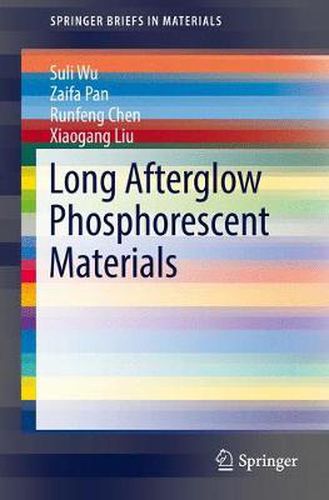Readings Newsletter
Become a Readings Member to make your shopping experience even easier.
Sign in or sign up for free!
You’re not far away from qualifying for FREE standard shipping within Australia
You’ve qualified for FREE standard shipping within Australia
The cart is loading…






This title is printed to order. This book may have been self-published. If so, we cannot guarantee the quality of the content. In the main most books will have gone through the editing process however some may not. We therefore suggest that you be aware of this before ordering this book. If in doubt check either the author or publisher’s details as we are unable to accept any returns unless they are faulty. Please contact us if you have any questions.
This book presents the fundamental scientific principles of long afterglow phosphorescent materials and a comprehensive review of both commercialized afterglow materials and the latest advances in the development of novel long afterglow materials. It is designed to supply much needed information about inorganic and organic afterglow materials, including detailed treatment of structure, classification, preparation techniques, characterization, surface modification chemistry, and optical measurements. Special attention is given to technological applications such as photovoltaics, photocatalytic reactions, and lighting and molecular sensing.
Although traditional long afterglow phosphors have been widely investigated and used in industry, and significant efforts have recently been made toward the use of these materials for bioimaging, there is to date no scientific monograph dedicated to afterglow materials. This book not only provides a beginners’ guide to the fundamentals of afterglow luminescence and materials, but also gives skilled researchers essential updates on emerging trends and efforts. The work provides a special focus on organic afterglow materials, which offer several advantages such as light-weight, flexible, and wide varieties; mild preparation conditions; and good processability. This book is aimed at postgraduate students, researchers, and technologists who are engaged in the synthesis, development, and commercialization of afterglow materials. It represents essential reading on interdisciplinary frontiers in the materials science, chemistry, photophysics, and biological aspects of afterglow materials.
$9.00 standard shipping within Australia
FREE standard shipping within Australia for orders over $100.00
Express & International shipping calculated at checkout
This title is printed to order. This book may have been self-published. If so, we cannot guarantee the quality of the content. In the main most books will have gone through the editing process however some may not. We therefore suggest that you be aware of this before ordering this book. If in doubt check either the author or publisher’s details as we are unable to accept any returns unless they are faulty. Please contact us if you have any questions.
This book presents the fundamental scientific principles of long afterglow phosphorescent materials and a comprehensive review of both commercialized afterglow materials and the latest advances in the development of novel long afterglow materials. It is designed to supply much needed information about inorganic and organic afterglow materials, including detailed treatment of structure, classification, preparation techniques, characterization, surface modification chemistry, and optical measurements. Special attention is given to technological applications such as photovoltaics, photocatalytic reactions, and lighting and molecular sensing.
Although traditional long afterglow phosphors have been widely investigated and used in industry, and significant efforts have recently been made toward the use of these materials for bioimaging, there is to date no scientific monograph dedicated to afterglow materials. This book not only provides a beginners’ guide to the fundamentals of afterglow luminescence and materials, but also gives skilled researchers essential updates on emerging trends and efforts. The work provides a special focus on organic afterglow materials, which offer several advantages such as light-weight, flexible, and wide varieties; mild preparation conditions; and good processability. This book is aimed at postgraduate students, researchers, and technologists who are engaged in the synthesis, development, and commercialization of afterglow materials. It represents essential reading on interdisciplinary frontiers in the materials science, chemistry, photophysics, and biological aspects of afterglow materials.